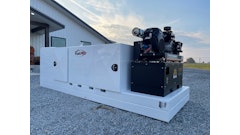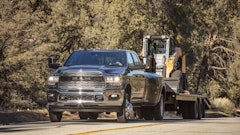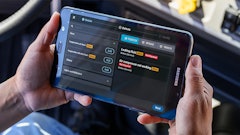
The job is done, and you’ve loaded your equipment. You aren’t thinking about whether or not your trailer can haul your skid loader, because you bought the right one. You want to get home, clean up, and enjoy your evening like everyone else. This is when it’s important to take five and double check that your load is secure and your trailer is ready to tow, and here’s how.
1 - Check the hitch
While it might seem obvious, the first thing to check is the hitch. It needs to be secured onto the ball or hook. This is easily overlooked when lowering the trailer to the receiver. Make sure the hitch is latched and check that the safety chains are hooked to the tow vehicle. They need to be hooked in two different spots on the tow vehicle, not to each other. Plug the wire harness into the tow vehicle for the lights and electric brakes. While doing so, attach the battery break-away cable and make sure the battery is fully charged as well.
While you’re looking at the hitch, chains and break-away cable, check that the parking jack is fully retracted so it cannot catch on an incline. Make sure all chains, drawbars and tools are secured so they don’t fly out while travelling down the road.
2 - Secure the deck
Securing loose objects or brushing off the deck is a must. If something falls off the trailer, there’s no telling which way it might bounce and it could easily damage another vehicle or cause injury to its occupants. This includes loose mud, sand, rocks and other materials that could be hazardous. Also, make sure equipment doors are properly latched and other items are secured.
3 - Take care of your wheels
Inspect the tires and make sure they are properly inflated. A digital pressure gauge is an accurate and fast way to check. Proper inflation ensures that the tire can perform according to its design. Under-inflated tires can cause excessive wear on the outside of the tread and allow heat to build up, causing early tire failure. Over-inflation can cause excessive wear on the center of the tread and cause the tire to break loose under some conditions.
Lug nuts must also be checked at specific intervals according to your trailer manufacturer’s owner’s manual. Make sure they are tight against the wheel. Proper maintenance should keep the lugs tight, but if you do see one that looks loose, make sure you tighten it and check the others on that wheel. One loose lug nut can cause enough vibration to loosen the others and pretty soon the lug bolts become worn. If there is damage, replace them immediately. Simply keeping the lugs tight can prevent costly repairs.
4 - Look at the lights
Take a quick walk-around to see that all of the lights are working. Replace any broken or damaged lights. It's also important that the red and white reflective conspicuity tape is not damaged or missing. Repair or replace any missing or damaged tape.
5 - Are the ramps right?
Finally, make sure that the ramps are fully secured. There should be locking pins or strong spring tension holding the ramps in place.
Haul safely
If you take five and check these areas, you'll increase your chances of safe hauling. Accidents can happen, but by making sure your trailer is safe, it greatly reduces the risk.
Take a few minutes before heading onto the highways to make sure you are hauling safely. It reduces stress on the trailer, it conserves time, and it can save a life. Use these tips and rest assured that you’ll have safe towing.




![[Video] Bechtel's 500-tire Trailer Transports Massive Loads to Panda Stonewall Energy Center](https://img.forconstructionpros.com/files/base/acbm/fcp/image/2016/12/default.585072ddb7961.png?auto=format%2Ccompress&fit=crop&h=167&q=70&w=250)














